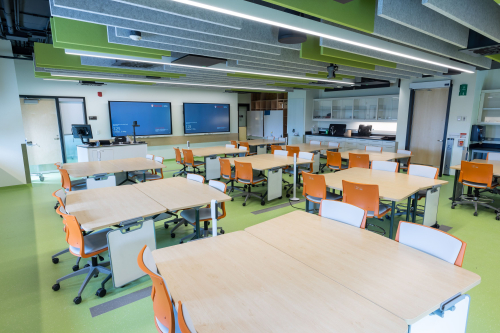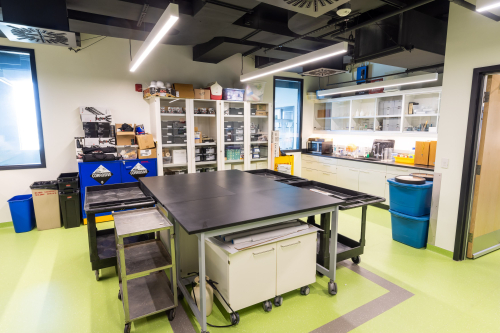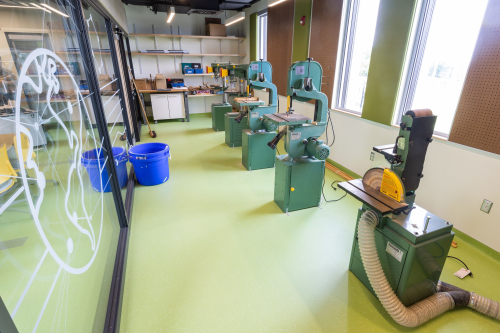- Location: 3700 McTavish Street, Montreal, QC
- Capacity: 35 students
- Type: Active Learning Lab
Alignment with Principles for Designing Teaching and Learning Spaces
Academic Challenge
Promote individual, active engagement with content.
Layout
Students can work individually, in pairs, or in teams of up to four people at movable tables. Each table has ample work surfaces for classroom materials (e.g., notebooks, laptops, and textbooks), as well as storage space for small and portable whiteboards.
Furniture
Comfortable, adjustable-height chairs on wheels permit students to work individually or in groups at their tables.
Technologies
Access to resources: Moveable power monuments for student laptops, LMS, internet (via student laptops and SMARTboards), wireless display. Multiple SMARTboards for simultaneous display of different learning materials. The room is enabled for web-conferencing with a ceiling camera and speakers, as well as a soundbar above one SMARTboard.
Lighting & Colour
Appropriate overhead lighting permits individual work during or outside of laboratory and class sessions. Green and yellow accents on chairs, acoustic panels, and other surfaces brighten the room.

Learning with Peers
Promote active engagement with one another.
Layout
Flexible furniture promotes face-to-face communication and group work. Students can easily circulate in the lab due to sufficient passing space between tables and discrete rooms for scientific equipment. Unobstructed sightlines.
Acoustics: Sound zones support multiple simultaneous conversations among students. Separate rooms for scientific and mechanical equipment help to separate different activities.
Furniture
Chairs on wheels permit students to turn and discuss with those nearby, supporting a variety of collaborative learning approaches. Tables allow students to work together collaboratively in small groups of up to four.
Technologies
Shared workspaces with two portable whiteboards at each table. Web-conferencing permits collaborating with students at external sites.
Lighting & Colour
Different lighting patterns and levels support different learning activities.

Experiences with Faculty
Promote interaction and communication.
Layout
Instructor’s podium has plenty of space for all equipment and for the instructor’s materials. The instructor has access to all students due to a layout that permits ample passing space, and clear sightlines. Glass walls effective separate lab space from the central classroom.
Acoustics: Sound zones ensure that not only are students able to hear the instructor, but that the instructor is also able to hear the students. Audio amplification is also available for instructors.
Furniture
The podium does not interfere with sightlines or movement, and has a large surface for instructional materials.
Technologies
Multiple classroom technology sources (document camera, computer, webcam, wireless display etc.) and three SMARTboards permit display of different learning materials. Web-conferencing capabilities allow the instructor to share video and audio online, and to include external participants.
Lighting & Colour
Lighting patterns support multiple types of teaching tasks.

Contributions to the Campus Environment
Labs that incorporate elements of active and collaborative learning are part of a vision for a variety of flexible campus learning spaces. This room is designed for all populations using the space: well-lit, with a standardized room control panel that simplifies instructors’ use of equipment in classrooms across campus. IT is consistent with teaching and learning needs, and durable furniture contributes to sustainability efforts. Both physical and virtual affordances help maximize High Impact Practices (HIPs) for student learning within and beyond this classroom.
